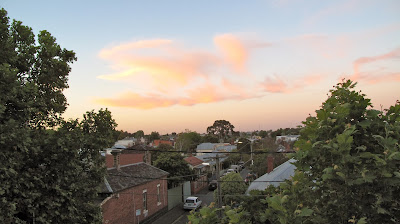Some say you should never begin any communication with an apology – a rule
that too often begs to be broken. This blog began with the best of
intentions – a weekly, or at the very least, a fortnightly post that would fill out the story of L. Bernard Hall, the man Australian art historians had overlooked
for far too many years.
No sooner had I started, however, than an entirely unexpected
move from country Victoria to inner suburban Melbourne threw everything into
chaos. Files that should have been informing the blog were packed for transport
and the writing itself was brought to a sudden and regrettable halt. For this I
can only apologise.
Now re-established, and with a great view from my desk over old Melbourne rooftops,
I am more than ready to take up where I left off - with the Hall paintings in the collection of Art Gallery of New South Wales. There are, of course, many
other reasons to explore this institution. The vast light-filled chambers that
house nineteenth and early twentieth century art are themselves, as Grace Hall
remarked in 1913, deserving of a leisurely inspection.
Among the artists represented in these ‘Grand Courts’ are
several of Hall’s British friends, including Luke Fildes and Hamo Thornycroft,
both of whom were unstinting in their praise for their younger colleague. The
work of Australian contemporaries, Walter Withers, Rupert Bunny, Frederick
McCubbin, Clewin Harcourt and John Mather can also be found here, alongside of
that of Hall’s one-time students Gordon Coutts, Hugh Ramsay, Max Meldrum,
Margaret Preston and Violet Teague. Paradoxically, it seems, you will probably
have to visit the Gallery’s storage areas to see the work of the man who, in
their own time, stood tall among them.
This Gallery holds five of Hall’s paintings. First to be
purchased (in 1910) was The Model, an
early example of the genre for which he is best known in Australia. The black
and white photograph on the left below was commissioned by the artist after the work was
finished, but the picture itself can be seen in full colour on the Gallery’s website
at http://www.artgallery.nsw.gov.au/collection/works/636/
The Model was among
the earliest of a sequence of similar paintings, which culminated with The Model and the Picture (on the right) in the late
1920s. As with any of Hall’s series, comparing the works offers some insight
into the way he manipulated his ‘props’ so that no two versions of a theme were
ever the same. (For any one in
Melbourne, a reminder that the later picture can still be seen at the
exhibition ‘Free, secular
& democratic: building the Public Library 1853–1913’ at the State
Library of Victoria – at least until the end of January 2014.)
There is another late nude in the New South Wales Gallery collection.
The Glass Bottle, http://www.artgallery.nsw.gov.au/collection/works/618/
was painted for exhibition in 1930, when the artist was seventy years old. Although
small in size, it showcases the technical achievement for which he was
justifiably applauded. The manipulation
of contrasting shapes, surfaces, textures and even brush-strokes to realise a
satisfying whole, and the play of light that sculpts the girl and glances off
the great demijohn for which the picture is named, are all characteristics of
Hall’s most admired work.
Some nine years after buying The Model, the Sydney Gallery Trustees purchased Coyness, http://www.artgallery.nsw.gov.au/collection/works/6061/,
a quaintly old-fashioned portrait that confirms Hall’s fascination
with the work of the seventeenth century Delft School. When I last saw this painting
it was hanging on the storage racks next to another of his portraits. The subject of Coquetry, http://www.artgallery.nsw.gov.au/collection/works/7060/, painted at much the same time as Coyness, is a vibrant young woman who would
not have been out of place on the lawns at a twenty-first century Derby Day. Hanging side by side, as they were then, these paintings witnessed another of Hall’s strengths. His ability to discern and exploit traits beyond
the purely physical gave his each of his simpler head studies a noteworthy individuality.
As with much of Hall’s work, these portraits warrant a leisurely personal encounter. For those without access to Sydney, however, its Gallery’s website offers a reasonable introduction. And, before I move on to discuss the two interiors in its collection, some more examples of this genre, in private hands, may be of interest. Unlike the images in his themed series, every small portrait stands alone.
As with much of Hall’s work, these portraits warrant a leisurely personal encounter. For those without access to Sydney, however, its Gallery’s website offers a reasonable introduction. And, before I move on to discuss the two interiors in its collection, some more examples of this genre, in private hands, may be of interest. Unlike the images in his themed series, every small portrait stands alone.





No comments:
Post a Comment